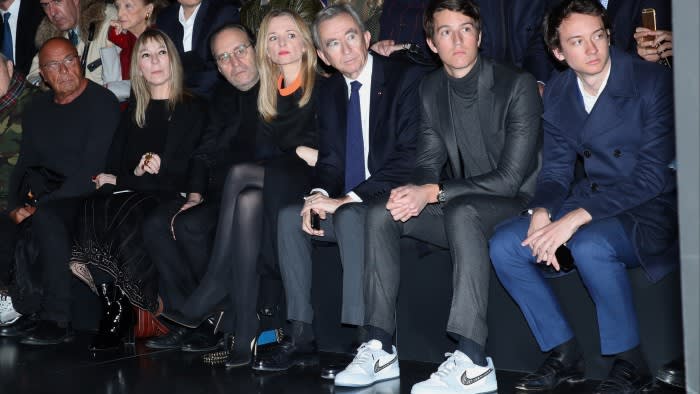Unlock the Editor’s Digest for free
Roula Khalaf, Editor of the FT, selects her favourite stories in this weekly newsletter.
The Bible said the poor will always be with us, but the verse neglected to mention the persistence of the rich. Perhaps it went without saying. I mention this because I have just taken on the job of editor of FT Wealth, nine years after I stopped editing a wealth-focused magazine, and the rich are as present and prominent now as then.
I have kept my eye on the world of the wealthy over this near-decade, particularly when it came to the art market, but am also catching up with contacts to find out what has changed — and which changes they think are in train for the rich and the industry that manages their riches. I asked several for their thoughts, pointers to a landscape that never settles.
It turns out that I need to adjust my wealthometer. Charlie Hoffman, managing director of HSBC Private Bank, pointed to the “acceleration of wealth accumulation at the top level of UHNWs, in particular billionaires. In 2015 ‘real’ wealth was generally measured in the hundreds of millions. Now it is in the billions.” (UHNWs stands for ultra-high-net-worth individuals and is defined as people with more than $30mn of investable assets. Or does it?)
Rich lists and wealth reports, though of variable reliability, confirm his view. The wealthiest at time of writing, according to the Forbes World’s Billionaires List, is LVMH patriarch Bernard Arnault and family, who are worth $233bn; Elon Musk ($195bn) and Jeff Bezos ($194bn) vie for second place. In 2015, top of the table was Bill Gates with $79.2bn, which would place him a mere 18th today. (Forbes currently assigns him $128bn, so he probably doesn’t feel too upset.) The 2015 World Wealth Report from Capgemini and RBC Wealth Management found there were 139,000 people with more than $30mn of investable assets; the 2024 edition raised that to 220,000.
Various factors have contributed. Daniel Pinto, founder and chief executive of Stanhope Capital Group, cited “the hyper-concentration of value creation around just a few large American technology companies”, which is reflected in the sources of wealth of most of the richest billionaires. Quantitative easing buoyed asset-owners without them even trying. The rise of wealth in Asia, especially China, has boosted European heritage luxury brands, such as the portfolios of LVMH, Kering and Richemont — and their owners.
The wealth boom has also had important consequences. Debbie Chism, a partner in law firm Stewarts’ divorce department, said: “Families are more international and mobile than they have ever been — the level of wealth in the hands of private individuals continues to grow at a seemingly exponential rate and their money flows around the globe more easily than ever.” This has presented challenges to governments less used to massive inflows, such as Singapore, whose normally peaceable banking system was shaken by a money-laundering scandal as family offices raced to set up shop there. Owen Walker and Chan Ho-Him’s sharp cover story looks at what the rise of wealth in Asia means for Switzerland.
So much for the past. There was surprising consistency among the six people I spoke to about what the biggest change in the wealth management industry will be: artificial intelligence. Rebecca Cockcroft, head of the family team at law firm Fladgate, said it would “reshape sectors across the board”, while James Whittaker, head of UK wealth management at Deutsche Bank, said it would be “making our business more efficient” and helping the wealthy in their decision-making. (Stanhope’s Pinto picked geopolitics with its splitting pushback against globalisation, citing “the economic cold war between the US and China”.)
Iain Tait, head of the private investment office at wealth manager London & Capital, paired past and future, reaching an unsettling conclusion. He said that as the rich have become richer, “middle-class incomes have remained relatively flat” and costs have surged. This “has created a sense of financial strain”, which has contributed to the rise of populist politicians — and AI, with further job automation, will only make this worse.
This has consequences for the wealthy. Debbie Chism at Stewarts sees an “increasingly polarised way that individual countries treat their rich” in the next decade, whether higher taxes for “those with broadest shoulders” in the UK or other countries trying to attract “the hypermobile wealthy”.
Interestingly, something no one mentioned (and, to be fair, it is somewhat longer-term, and I did only ask for one idea) was what is known as the great wealth transfer. In 2022, research company Cerulli Associates estimated that, by 2045, $84.4tn in assets would be handed on to subsequent generations by baby boomers and those before them. If that is the case, or even in the vague ballpark, it is a sluice of cash that is going to both boost and challenge the wealth management industry. Even the drips and rivulets of that money could be overwhelming. What you can be sure of is that FT Wealth will be tracking it.
Josh Spero is the FT’s wealth editor
This article is part of FT Wealth, a section providing in-depth coverage of philanthropy, entrepreneurs, family offices, as well as alternative and impact investment
https://www.ft.com/content/91fe3038-f8a3-46c3-949b-66f4ae635417


